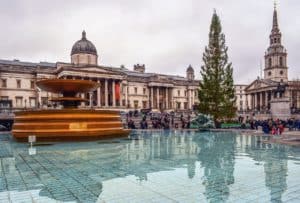The Practice of Falconry: Tracing its Cultural Journey from the Middle East to Europe

Updated On: April 07, 2024 by Yasmin Elwan
Falconry, an ancient form of hunting that uses trained birds of prey, is a testament to the enduring relationship between humans and nature. Its origins stretch as far back as Mesopotamia, with depictions, artefacts, and texts charting its prevalence across the Middle East and subsequently throughout Europe. Today, the practice of falconry is recognised by its inscription on the UNESCO Representative List of Intangible Cultural Heritage of Humanity, illustrating not only its historical but also its cultural significance across various nations. This living tradition continues to captivate enthusiasts worldwide, from the arid deserts of the Arabian Peninsula to the rolling green landscapes of Europe.

As we look beyond the hunting aspect of falconry, it becomes clear that the practice has evolved into a symbol of cultural identity and heritage. The meticulous care, training, and bond between the falconer and the bird reflect a deep respect for these magnificent creatures. The artistry of falconry equipment, the intricacies of training techniques, and the portrayal of falconry in arts and media enrich our understanding of the practice’s multifaceted nature. Furthermore, with the rise of global falconry practices, conservation efforts have gained prominence, ensuring the ethical treatment of birds of prey and the preservation of falconry for generations to come.
Historical Overview of Falconry
Falconry is an ancient art, deeply woven into the cultural fabric of societies ranging from the Middle East to Europe. This noble practice transcends mere hunting—it represents a rich tapestry of heritage, intertwined with history, literature, and traditional sports.
Falconry in the Middle East
Falconry’s roots are embedded deeply within the Middle East, where it has been a significant aspect of Arabic culture for thousands of years. Historical artefacts and literary works, including poetry and manuscripts, attest to its longstanding presence in this region. In particular, the Abbasid Caliph period provides a wealth of knowledge through detailed falconry manuscripts. These works not only reflect the technical aspects of falconry but also its status as a revered art. The Middle East Falconry Archive contains a wealth of such resources, encapsulating the profound relationship between humans and birds of prey. It is this age-old connection that has cemented falconry as an integral part of our collective heritage.
Spread to Medieval Europe
The tradition of falconry’s migration into Medieval Europe is equally rich in historical significance. The art was adopted by European nobility and became a symbol of status and privilege in medieval societies. It was during this period that falconry transformed into a sport laden with ceremony and sophistication. Scholars like Anne-Lise Tropato have dedicated extensive research to the impact of falconry on European cultural heritage. The reverence for this art is depicted through countless stories and books from the era, illuminating the prevalent role of falconry in the fabric of medieval life. It was also during this time that religious connotations emerged, as falconry was depicted in various Christian contexts, signifying purity and divine connection.
Cultural Significance of the Art of Falconry
Falconry holds a prestigious position within the rich tapestry of global cultural heritage. As we explore its cultural significance, we unveil how it transcends simple hunting practice to become a symbol of prestige and tradition deeply rooted in various societies from the Middle East to Europe.
Intangible Cultural Heritage
The art of falconry is acclaimed as an Intangible Cultural Heritage of Humanity by UNESCO. It is a cultural tradition that has been passed down through generations, embodying the skills, knowledge, and rituals tied to the relationship between humans and birds of prey. This recognition by UNESCO serves not only to celebrate the legacy of falconry but also to ensure its continued existence and reverence across cultures. Falconry’s inscription in the Representative List of the Intangible Cultural Heritage of Humanity highlights our collective responsibility to protect and nurture these living practices that form a core part of our global heritage.
Cultural Symbolism in Art and Literature
Historically, falconry has been a potent symbol in both art and literature, resonating with themes of nobility and the human connection with nature. Arabic calligraphy and paintings often depict falcons as emblems of power and purity. The influence of falconry is also found echoing in the strains of traditional music, which sometimes incorporates sounds and stories from falconry practices into its fabric. The representation of falcons and their handlers in various forms of art and literature not only reflects the importance of falconry within past societies but continues to be a source of inspiration and identity for many cultures today.
Conservation and Ethics

In the ancient practice of falconry, we find a unique blend of cultural tradition and modern conservation ethics. The sport mirrors our evolving relationship with nature, as it upholds the ethos of both preserving and respecting birds of prey and their habitats.
Sustainability in Falconry
Falconry embodies a strong commitment to the conservation of birds of prey, echoing sustainability in every aspect. Practitioners of falconry, known as falconers, are often at the forefront of habitat preservation efforts and are instrumental in increasing public awareness about the ecological roles these birds play. Our sustainability measures are carefully woven into the fabric of falconry, ensuring that hunting practices do not harm wild populations. Initiatives like the falcon release programme have been established to support raptor populations and maintain ecological balance.
Captive Breeding and Wildlife Conservation
We recognise captive breeding programmes as a key tool in wildlife conservation. By facilitating the careful breeding of birds of prey, we aim to bolster wild populations and preserve genetic diversity. Such programmes often serve as reservoirs for endangered species, allowing for reintroduction into their natural habitats when conditions are favourable. Furthermore, our involvement with UNESCO World Heritage sites confirms our dedication to maintaining falconry as a living human heritage, underscoring its significance in cultural and natural conservation worldwide.
Falconry as a Living Tradition
In our article, we examine falconry’s enduring presence, a testament to how this ancient practice continues to soar across generations and borders, from its heartland in the Middle East to the diverse cultures of Europe.
Community and Social Aspects
Falconry remains deeply woven into the social fabric of many communities, bridging the past with the present. Not only does it act as a recreational pursuit, but it also fosters community bonds and cultural exchange. In societies where it’s practised, it often represents a collective heritage, with knowledge and skills passed down through mentorship and apprenticeships. This aspect of falconry is embodied in gatherings where enthusiasts share experiences, celebrate successes, and ensure the continuity of traditions.
Modern Adaptations and Practice
As with many cultural practices, falconry has adapted to the modern world. Its essence as a method of hunting has shifted, with an increasing focus on conservation and education. Contemporary falconers often align their practice with ecological principles, playing active roles in wildlife rehabilitation and habitat protection. New technologies are also integrated, such as radio telemetry to track birds’ flights, highlighting a harmonious blend of tradition and modern innovation.
Through these means, falconry has not only survived as a practice but has flourished, finding new relevance and applications that resonate with concerns over biodiversity and the environment.
Anatomy and Training of Birds of Prey

Birds of prey are remarkable for their keen senses and agile flight, but their training is a nuanced art encompassing years of tradition. Mastery of falconry requires understanding each bird’s unique anatomy and instinctual behaviour. In this section, we’ll explore the specific training techniques and care management involved in the art of falconry.
Training Techniques
- Assessment of Maturity: The training process begins with the careful assessment of each bird’s maturity and readiness for training. Young birds, known as eyasses, are typically easier to train than older ones, which are called haggards.
- Weight Management: A crucial aspect of training is managing the bird’s weight to optimise responsiveness and motivation. Raptors are trained using a reward-based system where food is the primary incentive.
- Equipment Familiarisation: Birds of prey are gradually acquainted with essential falconry equipment such as hoods, jesses, and leashes.
- Basic Commands: Training progresses from basic commands to more complex tasks, such as returning to the glove or flying to a lure.
- Free Flight: Once trust is established, the bird is taught to fly free and return. This step requires patience and consistent reinforcement.
- Hunting Training: Ultimately, the bird is introduced to hunting, where its natural instincts are harnessed in a controlled environment.
By employing these techniques alongside a keen understanding of each bird’s abilities and temperament, falconers can develop a bond that is essential for the success of falconry.
Care and Management
- Housing: The birds require secure and comfortable housing, known as mews. These accommodations protect them from the elements and predators while providing ample space for them to rest.
- Health Monitoring: Regular health checks are vital, including monitoring for signs of stress or illness. This may involve periodic visits to an avian veterinarian.
- Feeding: Dietary needs must be met with a varied diet, often consisting of a selection of meats that mimics their natural prey.
- Hygiene: Maintaining hygiene is of utmost importance, with frequent cleaning of the mews and equipment to prevent disease.
- Exercise: Regular exercise is essential to keep the birds in optimal condition. A well-structured routine ensures they maintain their hunting instincts and physical prowess.
- Breeding: For those involved in breeding, maintaining genetic diversity and appropriate pairings is crucial for the continuation of healthy falconry stock.
The precise art of falconry demands not just skillful training, but also a comprehensive approach to the care of these majestic creatures. Whether for sport, conservation, or cultural heritage, the commitment to their welfare is a perennial priority.
Falconry Equipment and Dress

Falconry, the sport of kings, requires a range of equipment and attire that has been honed over centuries. Traditionally, these items served both practical and ceremonial purposes, and today, they blend heritage with modern technology.
Traditional Gear
In the realm of traditional falconry gear, the falconer’s gloves are paramount. Crafted from thick leather, these gloves protect the falconer’s hands from the bird of prey’s powerful talons. The hood, another essential item, is often beautifully decorated and serves to keep the raptor calm. Jesses, thin leather straps attached to the bird’s legs, assist in its control.
- Gloves: Thick leather, often extending beyond the wrist
- Hood: Decorated leather to calm the bird
- Jesses: Attached to the bird’s legs for control
For training and recall, the lure—a leather pad often with attached wings or meat—is swung to simulate prey, developing the hunting instincts of the raptor. Additionally, falconers wear a traditional dress which is both practical and part of the sport’s rich cultural heritage. This can include elaborately embroidered vests or cloaks that signify status or affiliation with falconry clubs.
Contemporary Innovations
In recent years, contemporary innovations in falconry equipment have improved the sport’s safety and efficacy. Modern tracking systems, for example, utilise GPS technology to ensure the bird of prey can be followed even if it flies out of sight.
- Tracking Systems: GPS devices attached to the bird for monitoring its location
New materials have also been introduced in making equipment, such as lighter and more durable synthetics for gloves and jesses. These innovations reflect a commitment to preserving falconry while embracing methods that enhance the interaction between falconer and bird.
International Falconry Practices

Falconry, the artful practice of hunting with birds of prey, spans the globe, embodying rich cultural heritage and diverse techniques. We explore falconry across different continents and delve into the local variants and technical nuances that make falconry a unique and esteemed tradition.
Falconry Across Continents
Middle East and North Africa: In the Arabian Peninsula, nations like the United Arab Emirates, Saudi Arabia, and Qatar have heavily-invested falcon hospitals and research centres in cities like Abu Dhabi. Falconry is not just sport, but also a symbol of status and heritage.
Central Asia: Kazakhstan and Kyrgyzstan maintain strong falconry traditions, with the Kazakh employing eagles to hunt hares and foxes. Falcons are revered in these regions and are often celebrated in festivals and community gatherings.
Europe: In Western Europe, countries such as France, Spain, and Italy have seen falconry evolve from necessity to sport. Each nation incorporates its own flair – in Spain, it is closely tied with equestrian activities. Northern and Central European countries such as Germany, Hungary, Czechia, and Poland practice falconry with a focus on conservation and education.
Local Variations and Techniques
The art of falconry is adapted to local environments and games. In Mongolia, the practice includes hunting with golden eagles, while Morocco’s falconers may target small game in the desert. Falcons are trained with great care, often becoming close companions to their handlers.
In Abu Dhabi, gyrfalcons are particularly prized, while in the Syrian Arab Republic and Iran, the training techniques have been passed down through generations, shaping a part of their cultural identities. Kazakh falconers use burkuts (golden eagles) to demonstrate their skills in festivals.
In countries like the Netherlands, Croatia, Ireland, and Slovakia, falconers value the sport’s potential to reconnect with nature. Meanwhile, in Sweden and Portugal, falconry serves both as a method of sustainable hunting and a tourist attraction, which helps to support local economies.
Through our united commitment to sharing and preserving the heritage of falconry, we honour the diverse practices that reflect the adaptability and resilience of this ancient art. Whether in the vast deserts of North Africa or the rolling green landscapes of Ireland, falconry remains a testament to our shared and enduring fascination with these remarkable birds of prey.
Falconry in Arts and Media
Falconry has not only been a cultural symbol across various societies but has also left an indelible mark on the arts and has found its way into contemporary media, enriching storytelling and visual expression.
Falconry in Visual Arts
Historically, falconry holds a revered place in visual arts, often depicted in paintings and tapestries. From medieval European works to Middle Eastern miniatures, falcons were symbols of status and nobility. In art galleries around the world, one can find portraits of aristocrats with a falcon perched on their hands, emphasising power and prestige. These artworks serve as a window into the social significance of falconry and its integration into cultural heritage.
Portrayal in Modern Media
Falconry continues to capture our imagination in movies and television, where it is portrayed as a noble and venerable tradition. Documentaries and dramatic features alike use the practice of falconry to convey a character’s connection with nature or heritage. Moreover, on social media, images and videos of falconry are shared widely, showcasing its global presence and appeal. Modern storytellers and creators continue to engage with this tradition, highlighting its enduring legacy and evolving cultural context.
Legislation and Falconry Clubs

In the realm of falconry, legislation serves to protect wild raptor populations and govern the practice of falconry, whereas falconry clubs and associations offer a framework for cultural exchange and the preservation of falconry heritage.
Legal Framework
The legal regulation of falconry is essential for ensuring the sustainable practice of this ancient art. Laws typically focus on safeguarding wild birds of prey while also allowing the traditions of falconry to continue under a structured and ethical framework. Legislation often requires falconers to adhere to specific guidelines, which may include registering their birds and participating in mentorship programs to demonstrate best practices. Regulations strike a balance between conservation needs and the minimisation of bureaucracy to avoid impeding the legitimate activities of falconers.
Falconry Associations and Organisations
Falconry associations and organisations play a critical role in the cultural and communal aspects of falconry. These entities provide members with support, education, and a means to share knowledge across generations. Notable organisations, such as the International Association for Falconry and Conservation of Birds of Prey, advocate for the interests of falconers worldwide, often engaging in dialogue with legislative bodies to influence policies that affect falconry. Likewise, local falconry clubs often act as the first point of contact for individuals seeking to learn about the practice, offering a wealth of resources and opportunities to connect with experienced practitioners.
Events and Festivals

Falconry has evolved from a method of hunting to a cultural spectacle, with various events and festivals celebrating this ancient art. These gatherings showcase the skills of both the falcons and their trainers, intertwining competition with cultural festivities.
Falconry Competitions
At the heart of falconry’s modern expression are the competitions. These events test the agility, speed, and precision of the birds, along with the expertise of the falconers. Al Ain hosts the renowned President’s Cup Falconry Competition, where birds of prey compete in races, displaying their hunting prowess. Participants from various nations come together, fostering a sense of community and reverence for this traditional sport.
Cultural Celebrations
Cultural celebrations take place within a jovial atmosphere, often at a majlis, where people gather to observe and participate in the rich traditions associated with falconry. Events like Al Razfa highlight the Bedouins’ bond with falconry, accentuating the art with traditional dance and poetry. These cultural events serve as vibrant reminders of the sport’s significance across the generations.
Frequently Asked Questions

We’ve compiled a list of frequently asked questions to offer insights into the rich tradition of falconry, which spans many centuries and cultures.
How has falconry evolved over the centuries in Europe?
Initially a hunting method, European falconry has become a symbol of status and heritage, infusing modern practices with a deep respect for its traditional roots.
What is the significance of falconry in medieval European culture?
In medieval Europe, falconry was an esteemed sport, often associated with nobility and chivalry, reflecting social hierarchy and fostering diplomatic relationships.
How did the practice of falconry spread from its origins to various parts of the world?
Falconry spread from the Middle East to Europe during the medieval period, primarily through trade routes and the expansion of empires, which facilitated cultural exchanges.
For what purposes has falconry traditionally been used by different cultures?
Throughout history, falconry has been employed for hunting games, while in certain cultures, it also served as a method of communication and a form of entertainment.
What role did falconry play in the social and political lives of Middle Eastern societies?
In the Middle East, falconry was more than a sport; it was integral to Bedouin survival and became a practice that symbolised honour, nobility, and prowess.
How are modern falconry techniques in Europe influenced by its historical practices?
Modern falconry in Europe often reflects historical practices, with falconers upholding the ethics and artistry that have been passed down through generations.






